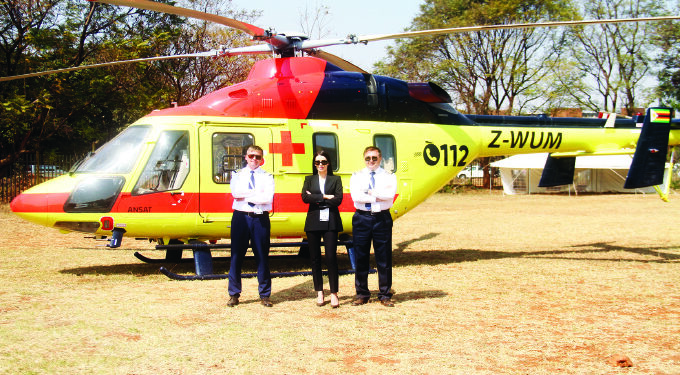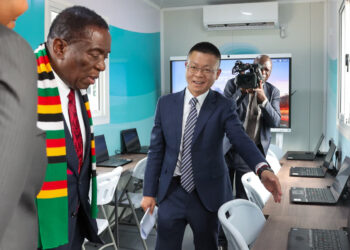THE Russian HeliDrive Air ambulances medical services team is in the country to set up an efficient air ambulance service that will be manned by highly skilled personnel to reduce fatalities caused by road traffic accidents under a public-private sector partnership agreement.
The recruitment and training of local personnel in handling air medical services has started with the company recruiting 40 local pilots, 50 doctors, 100 nurses, 100 dispatchers and 10 engineers.
The coming in of the Russian investor follows President Mnangagwa’s visit to the St Petersburg International Economic Forum in Russia in June where he toured HeliDrive Air Medical facilities.
President Mnangagwa is currently modernising the health sector as part of deliberate steps to create a modern, prosperous and highly industrialised country by 2030.
Air ambulances are primarily utilised to transport patients from inadequate levels of care to higher levels of intervention, or to repatriate them home if unable to travel via commercial flights.
These specialised aircraft are designed to navigate geographical barriers and provide the same level of medical care available in an intensive care unit (ICU).
Air ambulances are also sometimes necessary if a patient needs long-distance or emergency transport and is unable to use a commercial flight due to their medical condition.
These airborne ICUs are equipped with cutting-edge medical technology and staffed by highly trained medical personnel, ready to manage a wide spectrum of medical emergencies en route to care facilities.
This unique combination of speed, access, and comprehensive care capabilities positions air ambulances as a critical component of emergency medical services worldwide.
In Russia, the President toured the HeliDrive medical air services in St Petersburg, which provides air medical services to 70 percent of the Russian population. The tour, which included the operation centre’s factory, as well as a hospital in St Petersburg, was meant to ensure he gets first-hand information on how air medical services work in that country.
Zimbabwe will also explore opportunities for developing services that leverage on expertise in helicopter design and operations from Russia.
Last year, Zimbabwe took delivery of 18 brand-new helicopters from Moscow, which are providing emergency air medical services and law enforcement.
Some have also been deployed to the tourism sector and before the end of this year, the country would have received at least 32 helicopters under a public-private sector partnership agreement.
The helicopters are critical in Zimbabwe, considering the rising incidents of road traffic accidents.
Further, they are also set to boost the tourism sector, especially against the backdrop of assured health care for tourists through emergency air medical services that will be offered in resort areas like Mana Pools and Victoria Falls.
While in Russia, President Mnangagwa said he was confident that the programme would be successful.
“This tour has been an eye-opener. The air medical services are critical for Zimbabwe. I give it my blessings,” he said.
“I want this project to be inaugurated in Zimbabwe. We must have a centre, then we train a number of pilots, engineers, medical doctors and dispatchers.”
Helidrive’s co-owner Ms Julia Yatsenko said they are in the country to offer services in most parts of Zimbabwe.
“We are in the country to start work after President Mnangagwa came to Russia. This programme is free for all Zimbabweans according to the President. We have brought the best of
pilots, doctors and engineers to train and impart the knowledge to locals who will be using these air ambulances,” she said.
“We are recruiting 40 pilots, 40 doctors, 100 nurses and 10 engineers. At the moment we have 18 helicopters with 6 deployed to ZRP to deal with wildlife challenges whilst some helicopters will be for tourism and the public.
“Pilots will be trained at Charles Prince airport. Doctors and nurses are being trained at Sally Mugabe Hospital where we are also creating an Emergency Centre. The second phase of training will be in Bulawayo, Victoria Falls and Mutare”.
Ms Yatsenko said the helicopters are ideal for the African continent, especially Zimbabwe.
“Before the end of 2024, we are going to supply 32 helicopters. This, of course, will serve to make Zimbabwe one of the leaders in the field of providing emergency medical care.
“Considering that there are potential climate and road problems in this country, it is important to know that a helicopter can deliver a patient to hospital from any point in the country,” she said.
A nurse from Parirenyatwa Group of Hospitals, Brenda Mushawarima, who is currently undergoing training, hailed the programme.
“I am being trained to provide services during the golden hour, this is the first hour where the patient must be helped by the air services. In this ambulance we have monitors, ventilators, scans and drugs so this facility is like a mini-ICU. So here we can help the patient by stabilising them and then take them to hospital” she said.
The concept of the “Golden Hour” is paramount in emergency and trauma care. It refers to the critical first 60 minutes following a severe injury, where immediate medical intervention significantly increases chances of survival.












